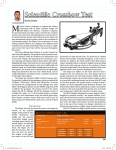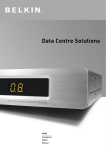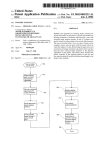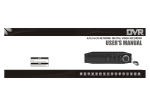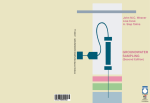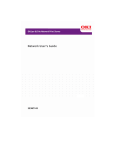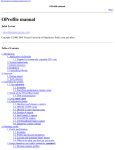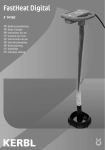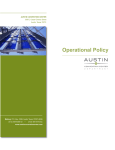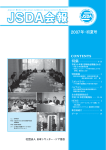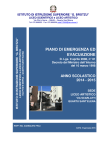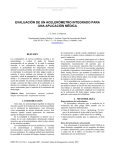Download ll 2o\\ REOORO OIEIS
Transcript
US 20070220365A1
(19) United States
(12) Patent Application Publication (10) Pub. No.: US 2007/0220365 A1
Castellani et al.
(54)
(43) Pub. Date:
METHOD FOR AVOIDING REPETITION OF
(22)
Filed:
Sep. 20, 2007
Mar. 17, 2006
USER ACTIONS BY USING PAST USERS’
EXPERIENCES
Publication Classi?cation
(75) Inventors: Stefania Castellani, Meylan (FR);
Nicola Cancedda, Grenoble (FR);
(51) Illt- Cl
G06F 11/00
(2006.01)
Maria Antonietta Grasso, Grenoble
(52)
(FR); Jacki O’Neill, Hebden Bridge
(GB)
Correspondence Address:
(57)
Patrick R. Roche
A method for assisting a user to correct a problem With a
FAY, SHARPE, FAGAN, MINNICH & McKEE,
LLP
SEVENTH FLOOR
1100 SUPERIOR AVENUE
CLEVELAND, OH 44114-2579 (US)
US. Cl. .............................................................. .. 714/46
ABSTRACT
device, such as a printer includes extracting, from records
comprising user actions on the device, a string of user
actions on the device. The string of user actions is compared
With at least one predetermined sequence of user actions for
correction of a prede?ned problem With the device. Based on
the comparison, an evaluation is made as to Whether at least
(73) Assignee: XEROX CORPORATION
one prior user has attempted the predetermined sequence
(21) Appl. No.:
repeating the prior attempt.
and, if so, a procedure is implemented to avoid a user
11/378,134
62\
EXTERNAL
' TROUBLESHOOTING r<))>r—l
KNOWLEDGE BASE
6%
I’
10
PRINTER
44
18
llI/O
16
MEMORY
2o\\ usER
REOORO
ACTIOOIEIS
A
\
'
"- 6o
INTERNAL
OIFIgTJEBIiIIESHOOTING
TROUBLESHOOTING
KNOWLEDGE BASE
38
34
'
PARsER
kw
F
36
IN REOOvERY
I N
OONIPARATOR
I
IDEAL AOTIONs
32v
OPERATION
INSJESSLTEO
vI
I30 A‘
- REOOROINO
FAULT OETEOTION
IvIOOuLE
MODULE
24
‘7
I
50
SENSOR
l
/ sENsOR
52
14
F‘N'SHER
//
/
40
'
mum:
EIEIEIC)
can (I)
IIIEIEIC)
GU] o c)
OOLOR
12 \ OARTRIOOE
/
.
‘
-/
,22
54
Patent Application Publication Sep. 20, 2007 Sheet 1 0f 4
62 \
V
US 2007/0220365 A1
_6_\
EXTERNAL
,
‘
TROUBLESHOOTING
><,%)>'—|
KNOWLEDGE BASE
’
E1
g
I
I
V
10\
PRINTER
MEMORY
\\
I/O
16\
20
A
REOORO 0F
USER ACTIONS
\
TROUBLESHOOTING
'
_
SYSTEM
/” 60
INTERNAL
~
TROUBLESHOOTING
KNOWLEDGE BASE
'
_
38
4/ 34
/36
/
OOII/IPARATOR
m?gg?go'“
OPERAT'ON
k
k
A
l
I!
v
F
v
v
A
I REOOROING
FAULT DETECTION
IvIOOULE
MODULE
5"“
//
/ SENSOR
52
‘14
F'N'SHER )2
GOLOR
CARTRIDGE ‘
‘FIG. 1
r
A!
24
V
" ‘I
SENSOR
\\
[3O
_
"
v
A
‘I /32
I
IN REOOvERY -/
PARSER
(
‘
54
IOEAL AGTIONS
/
/40
'
855%
g D U <3
E] El E] C)
GUI o o
\22
/
Patent Application Publication Sep. 20, 2007 Sheet 2 0f 4
US 2007/0220365 A1
3100
$102
;
\
PRINTER MALFUNCTION OCCURS
8104
1
.
1'
.
+ NEW USER DETECTS
MALFUNCTION
$108
MALFUNCTION
S106
-
S1 10
*
PRINTER DETECTS /
USER REPORTS
MALFUNCTION
\ FAULT DETECTION MODULE
RECORDS TIME
+
$112
PRINTER PROVIDES USER -/
WITH SEQUENCE OF
<
IDEAL USER ACTIONS
*‘
IF USER DOES
NOT CORRECT <FAULT
USER
USER PERFORMS ACTIONS
.
I
8114
r
PRINTER GENERATES DATA COMPRISING
USER
USER ACTIONS
NO'TIFIES
I
TECHNICIAN
0F FAULT
RECORDING MODULE STORES DATA
"
'
S136
sue
'
J’
EXAMINE RECORDED EVENTS:
+ CORRECTS
FAULT
$118
$134
'
S120
_/
PARSER SEGMENTS DATA INTO. ACTIONS
I
‘TO : FIG. 2B
Patent Application Publication Sep. 20, 2007 Sheet 3 0f 4
US 2007/0220365 A1
FROM.‘ FIG. 2A
*
122
COMPARATOR SELECTS
‘
j
WINDOW AND SEQUENCE STRING
SELECT STRING
TO BE ANALYZED.
USE STRING OF
EVENTS FROM A
FIXED MOMENT
NO
YES
SELECT STRING
TO BE ANALYZED.
WHILE THE FAULT
HOLDS, TAKE THE
WHOLE STRING OF
A FAULT DETECTED?
(E.G. START OF DAY)
'
ACTIONS AFTER IT
*
$124
+
COMPARATOR COMPARES STRING WITH IDEAL SEOUENCES
I
8126
SELECT PREDOMINANT EVENT(S)
-
I
'
8127
SEGMENT STRING INTO EVENTS
A
$128
COMPARATOR IDENTIFIES
REPEAT SEOUENCES OF ACTIONS
/
I I
8130
COMPARATOR
'
_/
IDENTIFIES OMITTED ACTIONS
I
'
INSTRUCTION MODULE RECEIVES
INFORMATION FROM COMPARATOR AND
GENERATES MODIFIED INSTRUCTIONS
A FIG. 2B
$132
/
>
Patent Application Publication Sep. 20, 2007 Sheet 4 0f 4
US 2007/0220365 A1
FIG. 3
Fault
w
Occurs
1
52
51
l l
l
t1 t2
t3
'Fault
Corrected
63
/-~
lI
l
\
t4
t5
t6
u1
U2
U3
|
I
l
"0 t7
t9
l ‘
;
t10
t8
FIG. 4
i
'
‘
v’v
'
1'
Fault
I
Fault
Occurs
l
l
|
l
to
T1
Corrected
l
|
\
l
l
l
T2
t3
124
11c
U1
U2
U3
-
t5
-I
l
t6
U4
t
;
Sep.20,2007
US 2007/0220365 A1
METHOD FOR AVOIDING REPETITION OF USER
ACTIONS BY USING PAST USERS’ EXPERIENCES
result in a Waste of user’s time, customer dissatisfaction,
doWn time of the printer, and reduced trust in the instructions
provided by the on-line support system.
BACKGROUND
[0001]
INCORPORATION BY REFERENCE
The exemplary embodiment relates to methods for
correcting a problem With a device, such as a printer. In
particular, it relates to the interactions betWeen a user and the
device, Which are informed by prior user interactions,
thereby reducing the repetition of unsuccessful user actions.
[0002] O?ice printers and multifunction devices (MFDs)
With printing capabilities are typically shared resources
Which are utiliZed by multiple users Who have access to their
services. When a printer malfunctions, a user Will often
[0005]
US. Pat. No. 6,556,926, entitled “SYSTEM FOR
DETERMINING WHEN A COMPONENT IN A PRINTER
SHOULD BE REPLACED,” by Haines discloses a com
puter that monitors one or more printers over a netWork in
order to determine When components in each of the printers
should be replaced. If the computer determines that a
component should be replaced, the computer can automati
cally transmit an order for a neW component to a vendor.
attempt to solve the problem themselves before seeking the
assistance of an experienced technician. Typical problems
[0006] US. Pat. No. 6,782,495, entitled “METHOD FOR
ANALYZING PRINTER FAULTS,” by Bernklau-Halvor
arise because of machine faults, such as paper jams, or poor
print quality on the output documents, e.g., White lines on
discloses a method of diagnosing a printer problem Which
includes correlating a Wide range of printer data types With
the paper. When a user has a problem With a printer,
suggested solutions. Printer diagnostic data, Which may
typically the user Will ?rst attempt to ascertain and ?x the
problem using Whatever built-in diagnosis tools are provided
With the printer. For some printers the built-in diagnostic
include usage information and printer status information
collected over a period of time, is parsed into individual
components. The components are then input into a set of
tools may be in the form of a user manual or diagrams on the
rules. Each rule compares each component With a corre
user interface shoWing possible locations of printer jams and
out-of-supply notices. For printers linked to a personal
computer, the install disk of the printer may include diag
correlates the comparison result With a set of actions includ
ing solutions, and if there is a correlation betWeen the
nostics in the form of a utility program to be run on the
comparison result and a solution, providing the solution.
user’s personal computer. Utility programs may offer sug
[0007] US. Published Patent Application No. 2003/
gestions for relatively minor problems, such as cleaning
inkjets to improve print quality or hoW to ascertain a printer
jam. Some of the problems can be readily solved by the users
With the help of instructions provided by the printer or made
sponding reference value to generate a comparison result,
0088528, published May 8, 2003, entitled “METHOD AND
SYSTEM FOR PRINTER SUGGESTED TRAINING,” by
Parry, discloses a system and a method for printer suggested
training using fuZZy logic analysis. A printer tracks printer
available to the user by an on-line support system, such as
a knoWledge base. Sometimes the user is not able to solve
usage relative to the features of the printer and the type of
the problem, and the assistance of local or remotely located
printer then selects an appropriate training package based
technicians is sought.
[0003] Solving the problems encountered can be time
consuming and frustrating for the users and costly for the
print jobs performed. Using a fuZZy logic protocol, the
upon the tracked usage. A message is then generated and
sent to a netWork administrator, or other user, suggesting the
selected training package.
oWner of the printer in terms of technical services and loss
of productivity. Diagnostic systems for identifying the cause
of the malfunction and help systems associated With the
printer can be of help to users in some instances. Machine
problems commonly have escalating stages of solutions,
either because the same symptoms may be caused by
BRIEF DESCRIPTION
[0008]
Aspects of the exemplary embodiment relate to a
method and a system for assisting a user to correct a problem
With a device. And to a method of forming such a system.
different faults With different solutions or the same fault may
have a number of different solutions, some more simple than
[0009] In one aspect, a method for assisting a user to
correct a problem With a device includes extracting, from
others. Thus, the online knoWledge base of a printer typi
records comprising user actions on a device, a string of user
cally shoWs a number of solutions Which should be tried in
actions on the device, comparing the string of user actions
order; With the simplest solutions being presented to the user
?rst and gradually progressing to the most complex solu
tions. Not all problems/solutions may be available in the
knoWledge base. For example, instructions to clear a jam
With at least one predetermined sequence of user actions for
correction of a prede?ned problem With the device and,
based on the comparison, evaluating Whether at least one
may be the ?rst level for a fault that indicates a jam.
prior user has attempted the predetermined sequence. If so,
the method includes implementing a procedure to avoid
HoWever the problem may actually be caused by dirty
repeating the prior attempt.
sensors, so the next level of troubleshooting (Which may not
be shoWn on the printer), may be to clean the sensors.
[0004]
Because of these different levels of solutions, a user
[0010] In another aspect, a system includes a user interface
for interacting With a user. A memory stores instructions for
identifying a string of actions on a device, instructions for
trying a particular solution may not solve the problem. Thus,
because of the shared usage of the printer, When a problem
comparing the string of actions With a predetermined
occurs, a number of users may folloW the instructions
provided by the printer yet be unable to solve the problem.
user based on the comparison. A processor retrieves records
comprising user actions on the device, the processor execut
Successive users may thus try to solve the problem Without
knoWing of the prior failed attempts of other users. This can
ing the instructions for identifying a string of actions, the
instructions for comparing the string of actions With at least
sequence of actions, and instructions for interacting With a
Sep.20,2007
US 2007/0220365 A1
one predetermined sequence of actions for correcting a
problem, and the instructions for interacting With the user.
[0011]
In another aspect, a computer readable medium
includes instructions, Which When executed on a processor,
extract, from records comprising user actions on a device, a
string of user actions on the device, compare the string of
user actions With at least one predetermined sequence of
user actions for correction of a prede?ned problem With the
device, based on the comparison, evaluate Whether at least
one prior user has attempted the predetermined sequence,
and implement a procedure for avoiding a repeat of the prior
attempt.
[0012]
ideal sequence) Which has been established for correction of
a prede?ned problem With the device. On the basis of the
comparison, an evaluation can be made as to Whether a prior
user has attempted the predetermined sequence. In particu
lar, the result of the comparison can be used as an indicator
of Whether a prior user has attempted the predetermined
sequence. A procedure can then be implemented to avoid
repeating the prior attempt, such as modifying the instruc
tions provided to a user from those provided during the ?rst
attempt, With a vieW to enabling the user to avoid repeating
an unsuccessful set of actions.
In another aspect, a method for forming a system
for assisting a user to correct a problem With a device
includes assigning elements of a ?nite alphabet to user
actions associated With a device, the actions including
actions taken to correct problems With the device. For each
of a plurality of ideal sequences of user actions for correct
ing problems With the device, a sequence of elements
corresponding to the actions is identi?ed and stored in
memory. Instructions are provided for comparing a string of
user actions on the device expressed in the ?nite alphabet
With at least one of the stored sequences to compute a
measure of similarity for use as an indicator of Whether a
prior user has attempted the stored sequence.
BRIEF DESCRIPTION OF THE DRAWINGS
[0013]
individual actions. The string of user actions is compared
With at least one predetermined sequence of user actions (an
FIG. 1 is a block diagram of a printing system
[0019] The evaluation of Whether a prior user has
attempted the recovery event may include computing a
measure of similarity betWeen a real sequence of actions and
an ideal sequence of actions. The similarity measure may
take into account various factors Which cause a sequence of
user actions to deviate from an ideal recovery event such as
the fact that certain user actions are not recorded, the
inclusion of actions Which do not form a part of in an ideal
recovery event, the repetition of actions, the extent to Which
certain actions are likely to be related to normal events,
unrelated to a recovery event, and the like. Thus, the
evaluation of Whether a user has attempted an ideal recovery
event may be a predictive determination in many instances.
[0020]
In another aspect, a system for providing instruc
tions to a user of a device includes a display for providing
instructions to a user, a processor Which retrieves stored data
according to the exemplary embodiment;
comprising records of user actions With the device, the
[0014] FIG. 2 is a How diagram of steps in an exemplary
method for reducing repetition in a fault correction process;
processor including instructions for identifying from the
[0015] FIG. 3 illustrates a timeline shoWing selection of a
WindoW for examining printer data in accordance With a ?rst
embodiment of the exemplary method; and
[0016] FIG. 4 illustrates a timeline shoWing selection of a
WindoW for examining printer data in accordance With a
second embodiment of the exemplary method.
DETAILED DESCRIPTION
[0017] Aspects of the exemplary embodiment relate to a
method and a system for correcting a problem With a device,
such as a printer and to a method of developing such a
system. While the exemplary embodiment is described With
particular reference to printers, it is to be appreciated that the
device can be any device subject to malfunction Which is
typically utiliZed by several users. Printers are exemplary of
such devices in that they are often utiliZed in organizations
as shared devices and as such tend to be situated in com
munal places easily accessible by their users, such as cor
ridors and alcoves. They are frequently shared by a number
of users and the on-printer troubleshooting instructions
along With users’ Work practices tend to lead to shared
responsibility for ?xing minor problems.
[0018] In one aspect, a method for providing a user With
instructions for correcting a problem With a device, such as
a printer, includes retrieving stored data Which includes
records of prior user actions With a device. From the records,
a string of user actions is extracted, for example, by selecting
a time WindoW in Which to examine the records and parsing
the stored records Within that time WindoW to identify
data a set of actions and instructions for comparing the set
of actions With a set of ideal actions Which comprise a
recovery event and instructions for determining Whether a
prior user has attempted the recovery event.
[0021] As used herein, a “printer” can include any device
for rendering an image on print media, such as a copier, laser
printer, bookmaking machine, facsimile machine, or a mul
tifunction machine. “Print media” can be a usually ?imsy
physical sheet of paper, plastic, or other suitable physical
print media substrate for images. A “print job” or “docu
ment” is normally a set of related sheets, usually one or more
collated copy sets copied from a set of original print job
sheets or electronic document page images, from a particular
user, or otherWise related. An image generally may include
information in electronic form Which is to be rendered on the
print media by the image forming device and may include
text, graphics, pictures, and the like. The operation of
applying images to print media, for example, graphics, text,
photographs, etc., is generally referred to herein as printing
or marking.
[0022]
As used herein an “action” generally refers to an
individual occurrence in Which a user interacts With a device
by performing a mechanical operation, e.g., opening a door
of the printer or manipulating, e. g., pulling out, a component
of the printer. In general, actions are the smallest operations
Which can be recogniZed by the printer. Actions Which may
be recorded by the printer include those Which are associated
With a recovery event and those Which are associated With
normal operation of the printer.
[0023]
A “recovery action” refers to any action of a user
associated With a printer With the object of correcting a
Sep.20,2007
US 2007/0220365 A1
problem or a perceived problem With the printer. Exemplary
user recovery actions in troubleshooting include opening
access panels to paper trays, removing and/or replacing
components such as toner cartridges, adjusting components,
removing trapped paper, and the like. The recovery actions
may take place in response to a printer request or may be
user initiated.
[0024] An “event” generally refers a sequence of actions
With the general purpose of obtaining a goal.
[0025] A “recovery event” generally refers to a sequence
of actions With the goal of correcting a problem With the
device. An ideal recovery event generally refers to a pre
de?ned sequence of ideal actions for correcting a knoWn
problem With the device. In general, the prede?ned sequence
includes at least tWo user actions to be performed in a given
order and often at least three such actions. It is to be
appreciated that some actions Which constitute recovery
actions When performed in a recovery event may also be
performed in a normal event, Which is not a recovery event,
such as in replenishing paper supplies.
[0026] A “user interaction” refers to the interactions of a
user With the device in a troubleshooting attempt. A user
interaction may consist of one or more recovery events.
[0027] A troubleshooting session may be considered to
run from the ?rst detection of a problem by the printer to the
resolution of that problem. Where the time at Which the
[0034] The extracted information may be offered to a
subsequent user, e.g., as a Warning, When giving instructions
to be folloWed to solve the problem. In one aspect, instruc
tions relating to prior user actions are incorporated into
instructions produced proactively by the printer in response
to a printer malfunction diagnosed by the printer. In another
aspect, instructions relating to prior user actions may be
provided in the context of user queries When a user is
searching for solutions to solve a certain problem of that
printer. In another aspect, the method includes informing the
user during the troubleshooting if the printer recogniZes that
the user is performing a sequence of actions already per
formed (in part) by other users.
[0035] FIG. 1 illustrates an exemplary printing system
including a printer 10 Which is con?gured With both printer
speci?c hardWare and softWare for performing the exem
plary method described herein. The printer 10 includes
conventional mechanical components 12, 14, a processor 16,
a communication interface (I/O) 18, a memory 20, and a user
interface 22, all interconnected by a bus 24.
[0036]
The communication interface 18 is arranged to
couple With an external netWork, such as local area netWork
(LAN) or Wide area netWork (WAN), and/or the Internet via
suitable Wired or Wireless links, to implement input/output
communications betWeen image-forming device 10 and
external devices, such as one or more host devices, e.g.,
problem occurred is not registered by the printer, the trouble
Work stations 26. Print jobs arrive at the printer from the
Work stations 26 via the communication interface 18.
shooting session can be considered to run from the ?rst
detection by a user or from some arbitrary point in time
Which may or may not precede the ?rst recovery action. It
trated as a ?nisher 12 and a toner cartridge 14, by Way of
example, are the mechanisms that are used to handle paper,
can consist of one or more recovery events that take place
Within one or more user interactions.
[0028]
The actions and the order in Which they are per
formed in a recovery event may be user selected or directed
by the printer or an associated or remote support service.
[0037] The mechanical components 12, 14, herein illus
to print documents, to assemble documents, and/or to pro
vide other additional functional characteristics to the printer
10. The mechanical components 12, 14 may include the
paper feeding mechanism, the inkjets of an inkj et printer, the
laser scanning assembly and revolving drum and other
associated mechanisms of a laser printer, ?nisher compo
[0029] The exemplary embodiment provides a printer help
system Which leverages knowledge about the past experi
nents, such as a document collator, a document binder, or a
In various aspects, the system and method alloW a
stapler, or any other mechanical component that may be
included in a printer 10 to increase its functionality, as Well
as access panels, such as doors, Which provide access to
components by a user Who is troubleshooting a printer
malfunction.
user Who encounters a problem at a printer to be informed
if other users have already tried a sequence of actions.
[0038] The processor 16 of printer 10 may be embodied in
a microprocessor board comprising circuitry. The processor
ence of other users interacting With the printer. This helps to
prevent or reduce some cases of Wasteful repetitions of user
actions When troubleshooting problems.
[0030]
[0031] In one aspect, the method includes recording all or
selected user actions With a particular printer, in particular
the actions linked to troubleshooting sessions, such as
actions for removing a paper jam, and maintenance opera
tions, such as periodic change of the toner or of the color
cartridges. From these records, information about past
troubleshooting experiences of users With the particular
printer can be extracted. The extracted information can be
used to determine:
[0032]
a. Whether any users have at least partially
folloWed troubleshooting instructions (a sequence of
ideal recovery actions) given by the device and have
not ?xed the problem.
[0033] b. Whether any users have tried recurrent
sequences of actions, even if not suggested as a trouble
shooting procedure.
16 may be a part of the existing circuitry associated With a
conventional printer and thus may be con?gured to perform
some or all of the speci?c functions of printer 10, including
control of printer speci?c hardWare and softWare. Altema
tively, the processor 16 may be a separate element and in one
embodiment, may be located remote from the mechanical
components 12, 14 of the printer, such as in a netWork server
or a Workstation 26, e.g., accessible via a Web broWser.
[0039] The instructions for the processor 16 can be instan
tiated as a computer program product. The computer pro
gram product can be a computer readable medium, such as
a disk, computer chip, or other electronic storage medium,
having a computer readable program code thereon. The
computer readable program code includes the instructions
executed by the processor 16.
[0040]
The processor 16 serves as a troubleshooting com
ponent Which includes a plurality of modules including a
US 2007/0220365 A1
fault detection module 30 Which detects printer malfunc
tions, a recording module 32, Which records data from the
printer comprising user actions With the printer, including
data on actions relating to an attempt to repair a printer
malfunction (recovery actions), a parser 34 Which extracts a
sequence of recorded user actions, a comparator 36, Which
compares the sequence of recorded user actions With one or
more stored ideal recovery events each comprising a
sequence of ideal user actions in order to compute a measure
of similarity betWeen the sequence of recorded user actions
and the ideal recovery event, and an instruction module 38,
Which generates appropriate instructions for the user based
on the computed similarity measure, all of Which may be
interconnected by the bus 24. Reports on the detected user
actions may be stored in the memory 20 in the form of RAM,
hard disk memory or other data storage medium. The
instructions may be provided to the user on a graphical or
audible display 40 of the graphical user interface (GUI) 22.
The instructions may be provided automatically or in
response to a user query. The user interface 22 may include
a user input device 42, such as a keyboard and/or a touch
screen, Whereby a user can interact With the printer, for
example, to report a printer malfunction, to interact With an
on-line help system, or the like. The GUI 22 may be
con?gured to display alphanumerical characters for convey
ing visual information to a user. For example, error condi
Sep.20,2007
time, improved customer satisfaction, reduced doWn time of
the printer, and increased trust in the on-line instructions.
[0044] A method of assisting a user of the printer to
identify and correct a problem With a printer Which may be
performed using the system illustrated in FIG. 1 is illustrated
in FIG. 2, and may include the folloWing steps. It Will be
appreciated that the steps need not be performed in the order
given and that feWer or additional steps may be employed in
the method. The method begins at step S100.
[0045] At step S102, a printer malfunction occurs. The
malfunction may be recogniZed by a user of the printer at
step S104 Who at step S106, may report the malfunction to
the printer via the user interface 22 and may provide the
printer With symptoms. Or, the user may try to correct the
problem Without notifying the printer that a problem has
been detected. Alternatively or additionally, at step S108, the
printer recogniZes that a fault has occurred, for example, by
receiving noti?cation from one of the printer components
12, 14, via the fault detection module 30. At step S110, the
printer, e.g., the fault detection module 30, stores a record of
the time at Which the malfunction is recognized, if this is
available. At step S112, the printer may access the knoWl
edge base and retrieve a set of ideal recovery actions
corresponding to a fault Which may be responsible for the
malfunction and presents these to the user, e.g., provides the
tions, status information, print information, and instructions
user With instructions via the user interface display 40.
Where the printer identi?es tWo or more different faults
for correcting a printer malfunction or other information can
Which may be responsible for the malfunction, the printer
be conveyed using the display 40. An exemplary display 40
is implemented as a liquid crystal display (LCD). The
modules 30, 32, 34, 36, 38 of the troubleshooting component
16 are con?gured to folloW a set of instructions 44 either
embedded therein, or stored in memory 20.
[0041]
One or more sensors 50, 52 are arranged to detect
information on a user action and communicate a record of
the action to the recording module 32. According to one
embodiment, sensors 50, 52 may be con?gured to detect the
interfacing of a user With respect to printer hardWare 12, 14,
such as a sensor Which detects the opening of an access door,
a manipulation of a user-accessible operational component,
or the like. Exemplary sensors 50, 52 are heat, light, motion
or pressure sensitive, although other sensor con?gurations
may be utiliZed to detect the actions of a user.
[0042] Repair instructions are available to the printer in an
on-line knowledge base 60 Which may be stored in memory
20. Printer problems commonly have escalating stages of
solutions, either because the same symptoms may be caused
by different faults With different solutions or the same fault
may have a number of different solutions, some more simple
than others. Thus the online knoWledge base 60 may include
a number of solutions Which are generally arranged to be
tried in order; from the most simple to the most complex.
Each of the solutions may include a sequence of ideal user
actions.
[0043] The troubleshooting system 16 alloWs a user to be
made aWare of solutions Which have been tried by other
users, or presented With solutions Which have not been
previously tried from those available in the database 60. By
exploiting information on users’ mechanical interaction With
the printer, users can be prevented from unnecessarily
repeating actions Which have been unsuccessfully carried
out before. This can result in a reduction in Wastage of users’
may present the user With instructions for curing the most
likely fault, or the fault Which is recti?able With the easiest
recovery actions. At step S114, the user may perform some
or all of the set actions provided by the printer. Or, the user
may perform another set of actions With the intent of
rectifying the problem. If the user does not correct the
problem at step S114, the user may leave the printer area
Without informing subsequent users that any recovery
actions have been performed. Steps S104, S106, S110, S112
and S114 may thus be repeated by one or more other users.
At step S116, (Which may be performed continuously or
intermittently prior to and throughout the method) the
printer generates data corresponding to actions at the printer,
including detectable user actions performed at step S114. At
step S118, the data is recorded, e. g., by the recording module
32. At step S120, the processor 16, e.g., the parser 34,
periodically examines the data and identi?es a sequence of
separate elements corresponding to actions. At step S122,
the processor e.g., the comparator 36, identi?es a time
WindoW comprising a candidate string of elements Which
may include elements corresponding to recovery actions by
the user. In the case that the printer identi?es that a problem
has occurred or a user noti?es the printer that a problem has
occurred at previous step S110, the WindoW start time may
be ?xed by the identi?cation or noti?cation time. Where no
problem is recognized, an arbitrary WindoW start time is
established.
[0046] At step S124, the processor, e.g., the comparator
36, compares the identi?ed string of actions With one or
more sequences of ideal actions stored in memory 20. This
step may involve computing a measure of similarity betWeen
a real sequence of actions and an ideal sequence of actions,
as described in greater detail beloW.
[0047] At step S126, a predominant event may be identi
?ed from the actions recorded Within the time WindoW. A
Sep.20,2007
US 2007/0220365 A1
predominant event can be a sequence of consecutive user
actions Which meets a threshold measure of similarity With
an ideal recovery event. This step may provide a single
candidate predominant event or a feW of them. HoWever it
does not indicate hoW many of these have occurred in the
given period of time. At step S127, the string is segmented
into events. By segmenting the sequence of actions into
system 62 on the printer (e.g. jam removal instructions
displayed on the printer screen), or manuals. An example of
a recovery event in the troubleshooting knoWledge base is
the set of actions listed above for removing a paper jam.
These tools describe “ideal sequences” of actions, that is,
prede?ned sequences of actions that are logically chained to
obtain a certain result. In general, they have a precise order,
events, this alloWs the number of such events to be counted
actions are clearly distinct from one another, and the start
in a subsequent step.
and the end of the problem can be easily recognized.
[0048]
[0058] There are a number of approximations and sources
of noise in the user interaction data recorded by the record
ing module 32, since not all human actions and faults are
At step S128, the comparator may, from the com
parison, identify one or more recovery actions or events
Which have not resulted in the correction of the fault, e.g.,
actions Which are repeated at least once. This may include
counting events by matching similarity against a predomi
detectable. For example, a user Who shakes a toner cartridge
or the presence of White lines on the paper may not be
nant event. This step may include counting hoW many
detected by the components 30, 32 of the troubleshooting
similar events have occurred once a predominant event has
component 16. Moreover, actual troubleshooting events are
not necessarily very close to ideal sequences. Several types
of discrepancy can occur including:
been detected.
[0049] At step S130, the comparator may identify action
steps of the ideal sequence Which Were omitted by a user at
step S114. At step S132, the processor may generate a
different set of user instructions, taking into account the
actions Which Were not successful in correcting the mal
function. For example, the processor may identify a different
set of ideal actions for curing the fault, or another fault
corresponding to the symptoms and provide a set of ideal
actions related to that fault, and/or may advise the user that
a particular user action did not correct the problem. The
method returns to step S112. The method may end at step
S134 When the user corrects the fault or at step S136, When
a user calls a service technician.
[0050] As Will be appreciated, a precursor step to the
method thus described includes the creation of reference
strings representing ideal events and storing them in
[0059] Incomplete events: an event is started but not
concluded.
[0060]
Redundant events: an event includes a repetition of
one or more actions.
[0061]
Modi?ed events: an event Where the order of some
of the actions has been changed.
[0062]
Noisy events: an event Which contains one or more
actions that are not part of an ideal sequence.
[0063] The comparator 36 compares the detected string of
actions With one or more ideal sequences of actions, Which
may be stored in the printer internal knoWledge base 60 or
accessed from an external knoWledge base 62. In order to
memory 20.
match ideal sequences With real sequences, a metric is
de?ned over the sequences to be compared Which accounts,
[0051]
problem of paper jam by clearing the paper jam in the
at least in part, for discrepancies of the types illustrated
above. Speci?cally, the exemplary method at step S126
?nisher interface, one event may comprise the folloWing
sequence of actions:
includes computing a measure of similarity betWeen a real
sequence of actions and an ideal sequence of actions.
[0052]
For example, When the user is trying to resolve the
1. Move the ?nisher on the right-hand side of the
printer, to the right, aWay from the printer.
[0053] 2. Open the ?nisher top cover on the ?nisher
interface.
[0054]
3. Remove the jammed paper. If the paper is
torn, make sure to remove any torn pieces of paper
inside the printer.
[0055]
4. Close the ?nisher top cover.
[0056]
5. Move the ?nisher to the left, toWard the
printer.
[0057]
From the records 44 of user interaction data cap
tured in the memory 20 of the printer, the troubleshooting
component 16 can extract information about past trouble
shooting experiences of users With the printer 10. In one
embodiment, at step S124 the method includes identifying,
from the records 44, candidate limited strings (sequences) of
user actions and at step S126, comparing them With
sequences of actions that each correspond to an ideal recov
ery event. The ideal sequences may be stored in trouble
shooting tools like a troubleshooting knowledge base 60,
e.g., the Xerox On-Line Support Assistant (OSA), an expert
[0064] In one embodiment, a sequence kernel, frequently
also referred to as string kernel is utiliZed by the comparator
36. String kernels provide the ability to recogniZe similari
ties among strings even When the symbols are not in perfect
sequence. They permit the detection of strings that represent
events Which are incomplete, modi?ed, redundant or noisy
as in the interaction data typical in a printer. A further
discussion of string kernels is provided by Lodhi, et al.,
“Text Classi?cation Using the String Kernel,” in Advances
in Neural Information Processing Systems 13 (MIT Press,
2001) and in Cancedda, et al. “Word-Sequence Kernels,”
Journal of Machine Learning Research, 3: pp. 1059-1082
(February 2003) (hereinafter “Cancedda”).
[0065] The string kernel computes similarity as the num
ber of occurrences of subsequences (in this case, sequences
of actions) shared by tWo sequences. The subsequences may
be contiguous or non-contiguous. A maximum length (num
ber of actions) n of the subsequences to be compared is set
before computing the string kernel. In general, n is at least
tWo, and for printers may typically be from about three to
about 6. The value of n may be higher in cases Where typical
ideal sequences include a large number of individual actions.
Non contiguous occurrences are penaliZed according to the
Sep.20,2007
US 2007/0220365 A1
size of the gaps they contain. The string kernel takes the tWo
sequences and returns a number.
[0066]
For example, let 2 be a ?nite alphabet of actions,
and let s=sls2 . . . s‘s‘ be a ?rst sequence of actions over such
alphabet (such as a string of user actions With the device).
Let i=[il, i2, . . . , in], Withi1<i2< . . . <inéi‘s‘, be a subset of
the indices in s (i.e., the positions of a particular subse
quence of actions). Let s[i] represent the (possibly non
contiguous) subsequence silsi2 . . . sin. Also, let l(i) be the
expression in—il+l, i.e., the Width of the WindoW in s
spanned by s[i]. Similarly, let r=rlr2 . . . rm be a second
sequence over the alphabet (such as an ideal sequence of
user actions).
[0067]
The sequence kernel Kn (s,r) of the tWo strings s
and rover E can be de?ned as:
AIUHIU)
(Eqn. 1)
[0073] As noted above, a precursor to the exemplary
method involves the creation of reference strings represent
ing ideal troubleshooting events in the same alphabet as is
utiliZed by the parser for identifying real events. A ?rst step
in the creation of reference strings includes a modelling
activity: recovery events are represented as non ambiguous
sequences of individual actions. This in turn involves tWo
subtasks: the identi?cation of an alphabet of actions, by
Which the actions can be described, and the encoding of
events as sequences over this alphabet. These subtasks may
be intertWined. TWo sources from Which the information for
performing these subtasks can be gathered are sequences of
recovery actions proposed by the printer to the user When a
fault is detected and the troubleshooting knoWledge base.
[0074] Several methods for modelling the data are con
templated. In a ?rst method, the ideal sequences of recovery
events of the kind described above can be manually coded
by analysing the content. This is feasible, although time
consuming, in the domain of printer malfunctions, since
sequences may be in the order of hundreds of actions, as is
evident from the content of an online knoWledge base. In an
alternative embodiment, an expert encoding the events is
[0068] Where n, the maximum subsequence length, is a
?xed positive integer and 7» is a gap penalty factor. 7» is a real
number betWeen 0 and 1 indicating the decay factor for each
supported by a structural and linguistic analysis of the
instructions describing recovery procedures. The linguistic
analysis may be provided by a processing module With
gap in subsequence occurrences. As noted above, n may be,
instructions for numbering of the steps or for the identi?
cation of verbs in the imperative form, eg ‘move the
?nisher to the left’ or ‘open tray 1.’ The thus formulated
sequence strings for a series of typical recovery events may
be stored in the printer memory, to be retrieved When a
printer malfunction occurs.
for example, 3, 4, 5, or 6 in the printer example. The decay
factor may be selected by trial and error to provide appro
priate Weighting for the presence of gaps. Where there are
naturally a large number of gaps in a string of user actions
(because, for example, only a portion of the user actions are
sensed by the printer), the gap penalty factor 7» may be loWer
(closer to 0).
[0069] Computing such a kernel amounts to performing an
inner product in a feature space With one dimension for each
subsequence ueZn, With feature mapping given by:
¢u(S): 2 A10)
(Eqn. 2)
[0075] At the time of a printer malfunction, the method
includes extracting information from recorded data, Which
may include the selection of sequences to be analysed and
the identi?cation of predominant events (step S126).
[0076] It Will be appreciated that actions may occur con
tinuously at the printer, only a feW of Which relate to
troubleshooting events. For example, documents are printed,
a fault occurs, a door is opened. All of these actions may be
detected by the recording module 32 of the troubleshooting
processor. In one embodiment, on a regular or intermittent
[0070]
Further details on hoW the string kernel technique
may be applied to sequences of user actions in a trouble
shooting operation are provided beloW.
[0071] Another approach for measuring similarity
betWeen a sequence of real actions and a sequence of ideal
actions is to use a basic edit distance. This is the minimum
number of symbol replacement, deletion and insertion
operations that are required to transform one of the tWo
sequences, such as the ideal sequence of actions, into the
other, e.g., the real sequence of actions.
[0072] In the present case, it is useful to match individual
ideal sequences against a real sequence Which may contain
several events. HoWever, When comparing a single ideal
sequence With a real sequence encoding multiple noisy
events, the edit distance does not take into account the
presence of multiple noisy occurrences of the ideal sequence
in the real sequence. In other Words, the edit distance may
detect that a certain recovery event (an ideal sequence of
actions) has been attempted, but it Would be unable to
estimate hoW many times it Was attempted.
basis, typically during printer idle times, recorded actions
are examined and information extracted therefrom by the
parser.
[0077] The next step is to detect sequences of actions
Which constitute an event (step S126). This includes the
identi?cation of sub-streams (“Windows”) Where one or
more events could have occurred, by segmentation of the
continuous stream of information coming from the parser of
the printer. This differentiation betWeen events may utiliZe
several automated strategies for clustering a sequence of
actions and labelling them With a common event tag. The
sequences of actions Which are of interest include human
interventions on the printer. While most faults and human
mechanical interventions are detected, some may not be
sensed by the printer. These actions can be considered as
“holes” in the actual event. Moreover, not all the technical
problems Which a printer may suffer result in a fault detected
by the printer. In general, there are minor technical de?
ciencies that are not sensed by the printer. These include
print quality problems, Which While not blocking use, could
trigger the user to attempt some troubleshooting actions.
Sep.20,2007
US 2007/0220365 A1
[0078]
It should also be noted that the actions that con
stitute a recovery event typically occur Within a time interval
that is signi?cantly shorter than the intervals betWeen
actions that belong to different events. This time proximity
can be exploited to cluster actions into recovery events.
Additionally, if the identity of the users performing the
actions has been captured this information may also be used
for clustering actions into events by associating them to
users. The user information may be captured, for example,
When a user enters his personal code before making a copy
or When a print job arrives at the printer from a user’s
Workstation With a ?le header Which provides user informa
tion.
ideal sequences of actions, such as all the sequences of ideal
actions available in the model. A detailed example is pro
vided beloW.
[0082] In a second scenario, illustrated by the timeline in
FIG. 4, the printer malfunctions at time tl as before, but no
fault is detected by the printer. This is the case, for example,
With degraded print or copy quality. At times t2, t3, t4, users
U1, U2, and U3, attempt, unsuccessfully, to correct the
problem. At time t5, the computation of the string kernel
indicates that at least one prior user has attempted a pre
de?ned ideal sequence. At time t6, the printer provides a
Warning message that a sequence has been attempted by one
or more prior users and may also provide a neW set of
[0079]
TWo methods are proposed for detecting a candi
date WindoW W containing one or more events (Step S122).
In the ?rst, a fault is detected by the printer (step S108 or
instructions for correcting the problem Which the string
kernel suggests has been attempted by the prior user(s). At
(step S112). This scenario is illustrated in the time line
time t6, a neW user U4 (or one of the prior users) sees the
Warning message/instructions and uses a different sequence
of actions to correct the problem.
shoWn in FIG. 3, Where t represents time. At time t1, a fault
occurs. At time t2, the printer recogniZes the fault has
[0083]
occurred. The printer may be con?gured for detecting a
number of faults and automatically suggesting troubleshoot
ing actions, for example When it detects a paper jam. At t3,
time in the past, for example the beginning of the Working
Step S106) and some instructions are presented to the user
the printer displays an error message. FolloWing the mes
sage of a fault, one or more users may perform actions in
order to resolve the problem according to the instructions
they are provided. For example, at time t4, a ?rst user U1
begins a series of actions. If this does not bring the printer
to a non-faulty state then the user may give up and other
users U2, and U3 could repeat the process at times t5 and t6,
respectively. At time t8, the printer may provide a neW set of
instructions folloWing identi?cation of repeated, unsuccess
ful actions by the users at time t7. At time t8, another user U4
(or one of the prior users U1, U2, U3) begins to correct the
fault. At time t9, the fault is corrected. At time t 10, the printer
detects that the fault has been corrected, and no longer
displays the error message.
[0080] The method in this case may rely on the fault
information from the printer to restrict the WindoW W of
In this scenario, no precise information on Where to
start searching for repeated events in the logged string is
available. A solution is to consider a meaningful reference
day to, as shoWn in FIG. 4 (or a selected number of hours
prior to the current time). The segmented string Will there
fore contain all actions from the beginning of, e.g., the
current day. Since no fault has been identi?ed in this case,
there is no indication of What the ideal sequence could be,
so the string of actions Will be directly compared With the
reference set of all ideal sequences. If a user action is
repeated, the resulting one or more events that Will exceed
a given threshold of similarity Will then be the ones looked
for counting the actual occurrences of them in the next step.
[0084] A further step (step S128) is to detect the repeated
execution of a sequence of actions. It Will be appreciated that
there may be sequences of actions performed in the normal
course of operations (e.g., to load paper trays) that might be
similar to recovery events. TWo possible solutions to this
problem are contemplated, Which can be combined or used
actions to consider. In the simplest case, a number of users
independently. The ?rst solution consists of modelling
carry out detectable actions Which may be equivalent to
explicitly not only recovery events but also events corre
ideal action steps stored in the knowledge base, thus making
sponding to normal, non-fault operations. The actual
each user interaction a sort of repetition of a sequence of
sequence of actions can then be matched against both fault
and non-fault ideal sequences, and a Warning message be
issued only in case a subsequence matching a recovery event
is not contained in a subsequence matching a normal opera
tion sequence With a higher score (as computed, for
events. The start t4 of the troubleshooting session can be
considered as the occurring When a ?rst user U1 attempts to
correct a fault already detected by the printer and ends at t1O
When the fault is no longer detected by the printer. The
reference WindoW W of considered actions is therefore
periodically computed at ?xed intervals or at intermittent
time intervals (e.g. during idle periods of the printer When no
user is interacting With it) and proceeds from the time of the
fault detection t2 until the current moment tC of computation.
The string of actions determined in this Way is the string of
actions that is then used to detect any recurrent events Within
it.
[0081] In one embodiment, using the string kernel’s simi
larity measurement technique, the logged sequence of
example, by the string kernel).
[0085] Moreover, if a sufficiently large number of action
sequences annotated With fault and non-fault events is
available, normal operation sequences can be acquired
through learning (as this reduces to a standard binary
classi?cation problem over sequences).
[0086] A second method for differentiating recovery
actions from normal operation actions consists in assigning
different Weights to different action/ symbols, namely giving
more importance to those actions that discriminate better
actions is ?rst matched against an ideal action sequence,
Which is a sequence of actions associated to a given fault. If
betWeen a fault recovery event and a normal operation event.
this measure does not reach a preselected threshold of
A generaliZation of the sequence kernel used according to
similarity, the string is then compared With a larger set of
the method in this case can be represented as folloWs:
Sep.20,2007
US 2007/0220365 A1
Kno, r) =
(Eqn- 3)
[0093] In one embodiment, a simple heuristic to segment
the sequence into events consists of looking at the elapsed
time betWeen actions. In general, it can be assumed that
actions contained in a same event are closer to one another
Z Z Z HA3“, N AW 1] Am
than actions belonging to different ones. For example in FIG.
3, 61 and 62 (i.e. the time interval among tWo user actions
belonging to the same event) are smaller than 63, represent
ing the time betWeen the last action from user U1 and the
?rst action of user U2.
[0087] Weighting schemes of this type are described, for
example, in Cancedda, et al. In the original string kernel
formulation (Eqn. 1) there is a single decay factor 7». This
factor is used to penalize in a uniform Way both matching
symbols and symbols appearing in gaps. Since all matching
subsequences have the same number of matching symbols
(namely 2n, i.e. n in each sequence), the overall effect is to
penalize by 7» all symbols appearing in gaps. Moreover, no
difference is made according to Which speci?c symbol is
matched or skipped.
[0088] In Eqn. 3, there are tWo sets of decay factors, kg and
km, the ?rst of Which is used to penalize gaps and the second
used to score matches. Each decay factor set includes a value
for each symbol (action) in the alphabet. The match score
Amp for a symbol a can then be set to a value based on the
discriminating poWer of o. If statistics on the number of
occurrences of o in fault and non-fault events are available,
an estimate of the conditional probability that an action
belongs to a recovery event given that it contains an occur
rence of a can conveniently be used as km, 0.
[0089] Assume, for example, that the alphabet contains a
symbol ‘RPJ’ for “Remove Paper Jam”. The decay factor for
[0094]
Once the actual events are detected as clusters of
actions, they can then be again measured against the can
didate ideal event selected in the previous step.
[0095] An alternative to estimate the number of occur
rences of each event consists in performing a partial nor
malization of the value of the sequence kernel betWeen the
actual action sequence and the ideal sequences. The value of
the sequence kernel, as presently de?ned, depends on the
length of the matched sequences: the longer they are, the
larger the chances that they Will share subsequences and the
higher the value of the kernel. In many applications it is
appropriate to normalize the kernel and make it independent
of the sequence length. This is usually done by replacing
K(s,t) With:
[0096] With this normalization, the value of K‘ has a value
of betWeen 0 and 1. However, When estimating the number
of occurrences of an ideal sequence in the reference
sequence, a different, partial, normalization is more conve
nient. By taking:
matches can be set:
[0097]
Where t is an ideal sequence, for K", a value
proportional to the number of occurrences of r in s is
c(fault, RPJ) + l
c(RPJ) + 2
obtained. Rather than providing an exact indication of the
number of occurrences, this estimate can usefully comple
ment the heuristics based on inter-event and intra-event time
[0090] Where p(fault]o) is the probability of an action
being related to a fault, c(RPJ) is the number of times that
RPJ appears in a training set of real user actions Which
includes both recovery and normal actions, c(fault, RPJ) is
the number of times RPJ appears in the corpus of stored
ideal recovery sequences, and a simple Laplace smoothing
is applied. In the likely event that almost all occurrences of
RP] belong to events tagged as ‘fault’, km’RPJ Will receive a
large value, close to l.
[0091] Conversely, the decay score kg,o Will be assigned
intervals mentioned above. It Will be appreciated that this
estimate is not possible if a simple edit distance is used
instead of the string kernel.
[0098]
Identifying the length n of the subsequences to be
matched can be dif?cult. If the value chosen is too large, then
only very feW subsequences Will match and pairWise simi
larity Will alWays be close to 0. If it is too small, on the
contrary, important information on the respective ordering
of symbols may be lost, and pairWise similarity Will be
overestimated. The most common Way to tackle this prob
lem consists in actually taking as value a linear combination
a value inversely proportional to p(fault]o) in order to
of the (normalized or partially normalized) values of the
penalize skipping a highly relevant symbol. In other Words,
kernels for all subsequence lengths up to a value n:
if tWo sequences differ by an occurrence of ‘RPJ’, this is
penalized more than if tWo sequences differ for an occur
rence of, say, ‘OT1’ (for “Open Tray 1”), Which occurs
frequently in normal (non-fault) sequences of actions. A
simple approach is to set kg,o=l—7tm,o.
"
.
(Eqn- 6)
ms. 1) = Z W‘KZ (s. r)
[0092] A further step (step S128) is to count hoW many
similar events have occurred once a predominant event has
[0099] With p. controlling the relative importance given to
been detected. The previous step (S126)-provides a candi
subsequences of increasing lengths. Information on recur
date predominant event or a feW of them. HoWever it does
rent events on the printer as extracted in the steps described
not indicate hoW many of these have occurred in the given
above can be provided to users When they reach the printer,
e.g., When they ?rst ?nd out that a problem has occurred, or
during their intervention on the printer, e.g., While the user
is trying to ?x a problem.
period of time. Thus, the sequence of actions is segmented
into events (step S127), in order to proceed to such enu
meration.
Sep.20,2007
US 2007/0220365 A1
[0100]
If a fault has occurred and the troubleshooting
system 16 is able to detect that a sequence of actions similar
to the suggested procedure has been attempted more than a
given number of times and more than others this may be
[0109]
ROT=Remove Old Toner
[0110] GA=Generic Action
[0111] Z={OFD, CFD, INT, ROT, GA}
indicated to the user as an estimation that there is another
problem that has to be solved ?rst or that the procedure has
not been folloWed properly by other users.
[0112] An example of a reference string: With respect to
the example Which consists of replacing the toner cartridge,
the reference sequence of actions (ideal sequence) may be:
[0101] If no fault has been detected but the troubleshoot
ing system 16 is still able to detect that a sequence of actions
[0113]
r=OFD ROT INT CFD
close to an ideal sequence has been attempted more than a
[0114] When dealing With this problem, several different
given number of times, and more than others, this may be
indicated to the user as an estimation that there is a problem
cases of events can be envisaged. The ?rst one exhibits the
exact sequence of actions. HoWever there could be users
that other users have already tried to ?x.
Who produce a noisy event, eg incompleteiif they do not
[0102] If a fault has occurred and the troubleshooting
system 16 does not detect outstanding recurrent sequences
of actions it may continue to attempt to detect recurrent
events While the user is performing actions on the printer
succeedior redundantiif they mix actions that are not
really required. The case of a modi?ed event is not appli
cable in this case as there are no successful permutations of
these actions. An example of modi?ed event is shoWn in
Example 3. The exact sequence can be represented by:
using candidate events prepared during idle times.
[0115]
[0103]
o=OFD ROT INT CFD
Without intending to limit the scope of the exem
plary embodiment, the folloWing examples illustrate appli
[0116] An incomplete sequence can be represented by:
cation of the method to changing the toner and to clearing a
[0117]
paper jam.
EXAMPLE 1
[0104] As a ?rst example, an illustration of hoW the
sequence kernels are applied Will noW be described With
reference to ‘changing the toner’. Changing the toner may
be performed in response to a message on the printer or to
an image quality problem. This example has been used for
simplicity, being the shortest troubleshooting sequence.
While being a simple and simpli?ed example, the “changing
the toner” event is nonetheless applicable since it has been
ob served that different users changed the toner several times
in the hope of addressing a print quality problem and Without
knoWing that other users had already tried that many times.
It should be remembered that the users folloWing the exact
sequence of actions, such as replacing the toner or removing
a paper jam, may still not have solved the problem. This is
one example of a process that the troubleshooting system is
readily able to Warn users against, i.e. doing that sequence
of action does not solve the problem, as, for example, ten
users have already tried the same sequence of actions. This
o=GA GA OFD ROT CFD GA GA
[0118] In the above example, the user has omitted the step
INT. A redundant sequence can be represented by:
[0119]
o=GA OFD ROT CFD OFD INT CFD GA
[0120]
In the above example, the user has repeated the
OED step and added a CFD step, out of order. A noisy
sequence may be represented by:
[0121]
o=GA OFD GA GA ROT INT CFD GA
[0122]
In the above example, the user has added different
steps from those prescribed. Other sequence s may have no
relation to the ideal sequence, such as:
[0123]
o=GA GA GA GA GA GA GA GA
[0124] The ?rst step of the method is to measure Which
event is most recurrent in a given logged string. Assume that
tWo users had already tried to replace the toner. The logged
string could be as folloWs:
[0125] GA GA OFD ROT INT CFD GA GA GA GA OFD
ROT CFD GA GA
example, then, is used to illustrate all the possible events that
can be associated With this error and the principle of hoW the
sequence kernels are applied.
[0126] A measure against the set of ideal sequences Would
identify the string ‘OFD ROT INT CFD’ as the most likely
[0105] The Alphabet: An alphabet is de?ned so as to be
able to describe the actions taken at the printer. This is a
simpli?ed example Where most of the remaining actions are
reduced to the Generic Action (GA). It Will be appreciated
that in an actual system, GA Will be replaced With a variety
time intervals betWeen different actions (Step S127) returns
of different symbols.
[0106] OFD=Open Front Door
candidate. At this stage, assume that segmentation based on
the strings:
[0127]
01; GA OFD ROT INT CFD
[0128]
02; OFD ROT CFD
[0129]
03; GA GA GA
[0130] The value of the non-normaliZed kernel K (Eqn. 1)
[0107]
CFD=Close Front door
betWeen each such observed sequence and the ideal
sequence, assuming parameters 7»=0.5 and n=3 are listed in
[0108]
INT=Insert NeW Toner
the ?rst roW of TABLE 1, as folloWs:
Sep.20,2007
US 2007/0220365 A1
10
[0146]
TABLE 1
K
K’
K
[0131]
For the case of an exact match: o1=SFO, OFTC,
RJP, CFTC, SFB, n=3 Values of ¢u(s) and ¢u(t) are given in
01
02
03
0.039062
0.772667
1.423016
0.007812
0.316228
0.819716
0
0
0
TABLE 3 beloW:
TABLE 3
By Way of illustration, the value of the ?rst cell
may be computed by considering the following matching
subsequences in TABLE 2:
TABLE 2
U
44(8)
0.0)
SP0, OFTC, RIP,
SP0, OFTC, CFTC
2.3
2.4
2.3
2.4
SP0, OFTC, SFB
SP0, RIP, CFTC
2.5
2.4
2.5
2.4
SP0, RIP, SFB
2.5
2.5
SP0, CFTC, SFB
2.5
2.5
2.3
U
Mi)
M01)
OFD ROT INT
OFD ROT CFD
0.125 (7.3)
0.0625 (2.4)
0.125
0.0625
OFTC, RIP, CFTC
2.3
OFD INT CFD
ROT INT CFD
0.0625
0.125
0.0625
0.125
OFTC, RIP, SFB
2.4
2.4
OFTC, CFTC, SFB
RIP, CFTC, SFB
2.4
2.3
2.4
2.3
K3(OFD ROT INT CFD, GA OFD ROT INT CFD)
= A3703 + A4704 + A4204 + A3703
= 0.015625 + 0.00390625 + 0.00390625 + 0.015625
1%;(SFO OFTC RIP CFTC SFB, SFO OFTC RIP CFTC SFB) = A3}? +
A A4 + A5705 + A4704 + A5705 + A5705 + A3703 + A4704 + A4704 + A3703
= 0.0390625
[0132] In order to have similarity measured independently
of sequence length, the normalized version (Eqn. 5) can be
For an incomplete sequence, such as: o2=GA, GA, SFO,
used, Which ensures that the value is alWays betWeen 0 and
OFTC, CFTC, GA n=3
1. After normalization, kernel values K' are as shoWn in the
second roW of TABLE 1.
[0147] Values of ¢u(s) and ¢u(t) are given in TABLE 4
beloW:
[0133] Taking a linear combination of the normalized or
partially normalized values of the kernels for all subse
quence lengths up to a value 11 using Eqn. 6 With [1. control
TABLE 4
ling the relative importance given to subsequences of
increasing lengths and assuming p.=0.5 (the maximum value
U
(MS)
4160)
is noW 1.75), the values of KD obtained are as shoWn in the
SP0, OFTC, RIP
23
0
SP0, OFTC, CFTC
2.4
2.3
SP0, OFTC, SFB
SP0, RIP, CFTC
SP0, RIP, SFB
SP0, CFTC, SFB
OFTC, RIP, CFTC
OFTC, RIP, SFB
OFTC, CFTC, SFB
RIP, CFTC, SFB
2.5
2.4
2.5
2.5
2.3
2.4
2.4
2.3
0
0
0
0
0
0
0
0
third roW of TABLE 1.
EXAMPLE 2
[0134] This example applies the method to the clearing of
a paper jam. In this case, the Alphabet may include the
folloWing symbols:
[0135]
SFO=Slide Finisher Out
K3(SFO OFTC RIP CFTC SFB, SFO OFTC CFTC) = 2.42.3
[0136] OFTC=Open Finisher Top Cover
[0148] Other examples of incomplete sequences may be:
[0137] RJP=Remove J ammed Paper
[0138] CFTC=Close Finisher Top Cover
[0139] SFB=Slide Finisher Back
[0140] OT1=Open Tray 1
[0141] CT1=Close Tray 1
[0142] GA=Generic Action
[0152] o6=SFO, SFB, SFO, OFTC, RIP, CFTC, SFB
2={SFO, SFB, OFTC, CFTC, RIP, 0T1, CT1, GA}
[0153] An example of a noisy sequence may be:
[0143] For removing the jam in the ?nisher area, the
reference sequence of actions (ideal sequence) is:
[0154] 07=sPo, OFTC, 0T1, CT1, RIP, CFTC, SFB
[0144] r=SFO, OFTC, RJP, CFTC, SFB
and 7»=0.5 and normalized values K' are given in TABLE 5,
together With values obtained by a linear combination KB of
[0145]
The similarity measures for each case of a detected
event are measured.
[0149] o3=OFTC, CFTC, SFB
[0150] o4=SFO, OFTC, SFB
[0151] O5=GA, GA, SFO, OFTC, CFTC, OFTC, RIP,
CFTC, SFB, GA
[0155] Non-normalized kernel values K (Eqn. 1) With n=3
different subsequence lengths With p.=0.5 (Eqn. 6).
Sep.20,2007
US 2007/0220365 A1
TABLE 5
Kernel
01
02
03
04
05
06
07
K
K’
K
0.065430
1
1.75
0.007812
0.088486
0.315813
0.007812
0.244339
0.682923
0.003906
0.122169
0.513650
0.065674
0.476697
0.989104
0.049805
0.501571
1.065886
0.028076
0.316298
0.828646
EXAMPLE 3iA Modi?ed Event
[0156] For the action of Clear Duplex Module, Upper Left
Door, Remove and Reinstall the Copy/Print Cartridge, the
Alphabet may include:
[0157]
[0158]
[0159]
[0160]
[0161]
[0162]
[0163]
LDMiloWer duplex module
LBTiloWer bypass tray
OBiopen ba?le
RJPiremove jammed paper
CBiclose ba?le
OULDiopen upper left door
RJPiremove jammed paper
[0164]
OLFC4open left front cover
CLFC4close left front cover
[0168]
CULDiclose upper left door
made by those skilled in the art Which are also intended to
be encompassed by the folloWing claims.
1. A method for assisting a user to correct a problem With
a device, comprising:
extracting, from records comprising user actions on a
device, a string of user actions on the device;
comparing the string of user actions With at least one
predetermined sequence of user actions for correction
of a prede?ned problem With the device;
based on the comparison, evaluating Whether at least one
prior user has attempted the predetermined sequence;
and
[0165] RPCiremove print cartridge
[0166] RlPCireinstall print cartridge
[0167]
ent systems or applications. Also that various presently
unforeseen or unanticipated alternatives, modi?cations,
variations or improvements therein may be subsequently
implementing a procedure to avoid repeating the prior
attempt.
2. The method of claim 1, Wherein the comparing of the
string of user actions With the predetermined sequence of
actions includes computing a measure of similarity between
the string of user actions and the predetermined sequence.
3. The method of claim 2, Wherein the computing of the
[0169] CDM4close duplex module
[0170] GA=generic action
measure of similarity includes at least one of:
[0171] 2={LDM, CDM, LBT, OB, CB, RJP, OLFC,
CLFC, RPC, RIPC, OULD, CULD, GA}
Exact String:
[0172] r=LDM, LBT, OB, RJP, CB, OULD, RJP, OLFC,
RPC, RIPC, CLFC, CULD, CDM
computing a string kernel value; and
computing a minimum edit distance between the string of
user actions and the predetermined sequence.
4. The method of claim 3, Wherein the computing of the
string kernel includes Weighting user actions according to
the likelihood of their occurrence in correction of a problem
relative to the likelihood of their occurrence in normal
Modi?ed String Examples:
[0173] o1=LDM, LBT, OULD, RJP, OLFC, RPC, RIPC,
CLFC, CULD, OB, RJP, CB, CDM
[0174] o2=LDM, LBT, OB, RJP, CB, OULD, OLFC,
RPC, RIPC, CLFC, RJP, CULD, CDM
[0175] Table 6 shoWs Non-normalized kernel values (Eqn.
1), With n=3 and 7»=0.5, normalized values (Eqn. 4), and
linear combination of different subsequence lengths With
p.=0.5.
events.
5. The method of claim 3, Wherein the computing of the
string kernel includes comparing subsequences of the string
of user actions and subsequences of the predetermined
sequence and penalizing gaps in the subsequences of the
string of user actions.
6. The method of claim 1, further comprising comparing
the string of user actions With at least one predetermined
sequence of user actions associated With a normal user
interaction With the device to eliminate from the evaluation,
strings of user actions Which are more likely to be associated
With normal interactions than With correction of a prede?ned
TABLE 6
String Kernel Values
R
01
02
K
K’
0.300663
1
0.155302
0.528086
0.208734
0.709776
Kn
1.75
1.150438
1.374164
problem With the device.
7. The method of claim 1, Wherein the implementation of
the procedure includes interacting With the user.
8. The method of claim 7, Wherein the interaction With a
user includes providing a modi?ed sequence of user actions
for correcting the predetermined problem.
[0176]
It Will be appreciated that various of the above
disclosed and other features and functions, or alternatives
thereof, may be desirably combined into many other differ
9. The method of claim 8, Wherein the modi?ed sequence
of user actions dilfer from those provided during recording
of the prior attempt.
Sep.20,2007
US 2007/0220365 A1
10. The method of claim 7, wherein the interaction With
a user includes advising the user of the prior attempt.
11. The method of claim 1, Wherein implementation of a
procedure includes providing a user With instructions Which
enable the user to avoid repeating a previously performed
sequence of user actions.
12. The method of claim 1, Wherein the extraction of a
string of user actions on the device comprises coding the
recorded user actions With symbols from a ?nite alphabet,
the sequence of ideal actions being expressed as symbols
from the ?nite alphabet.
13. The method of claim 1, further comprising:
identifying a time WindoW from Which the string of user
actions is extracted.
14. The method of claim 13, Wherein the extracting of the
string of user actions on the device includes identifying a
plurality of strings of user actions Which are sufficiently
spaced in time to be considered as separate user interactions.
15. The method of claim 1, Wherein the string of user
actions includes user actions recorded subsequent to a
detection of a fault by the device.
16. The method of claim 1, Wherein the string of user
actions includes user actions recorded subsequent to a
instructions for comparing the string of actions With at
least one predetermined sequence of actions for cor
recting a problem, and the instructions for interacting
With the user.
21. The system of claim 20, Wherein the instructions for
comparing the string of actions With a predetermined
sequence of actions comprise instructions for computing at
least one of:
a string kernel value; and
a minimum edit distance betWeen the string of user
actions and the predetermined sequence of actions.
22. A computer readable medium comprising instructions,
Which When executed on a processor;
extract, from records comprising user actions on a device,
a string of user actions on the device;
compare the string of user actions With at least one
predetermined sequence of user actions for correction
of a prede?ned problem With the device;
based on the comparison, evaluate Whether at least one
prior user has attempted the predetermined sequence;
and
predetermined reference time.
17. The method of claim 1, Wherein the device is a printer.
18. The method of claim 1, Wherein the extracting,
comparing, and evaluating and implementing are executed
by a processor.
19. The method of claim 1, Wherein the records further
comprises device information, and Wherein the device infor
mation comprises device operational and fault status infor
mation generated over a period of time.
20. A system comprising:
a user interface for interacting With a user;
memory Which stores instructions for identifying a string
of actions on a device, instructions for comparing the
string of actions With a predetermined sequence of
actions, and instructions for interacting With a user
based on the comparison;
a processor Which retrieves records comprising user
actions on the device, the processor executing the
instructions for identifying a string of actions, the
implement a procedure for avoiding a repeat of the prior
attempt.
23. A method for forming a system for assisting a user to
correct a problem With a device, comprising:
assigning elements of a ?nite alphabet to user actions
associated With a device, the actions including actions
taken to correct problems With the device;
for each of a plurality of ideal sequences of user actions
for correcting problems With the device, identifying a
sequence of elements corresponding to the actions and
storing the sequences in memory;
providing instructions for comparing a string of user
actions on the device expressed in the ?nite alphabet
With at least one of the stored sequences to compute a
measure of similarity for use as an indicator of Whether
a prior user has attempted the stored sequence.

















